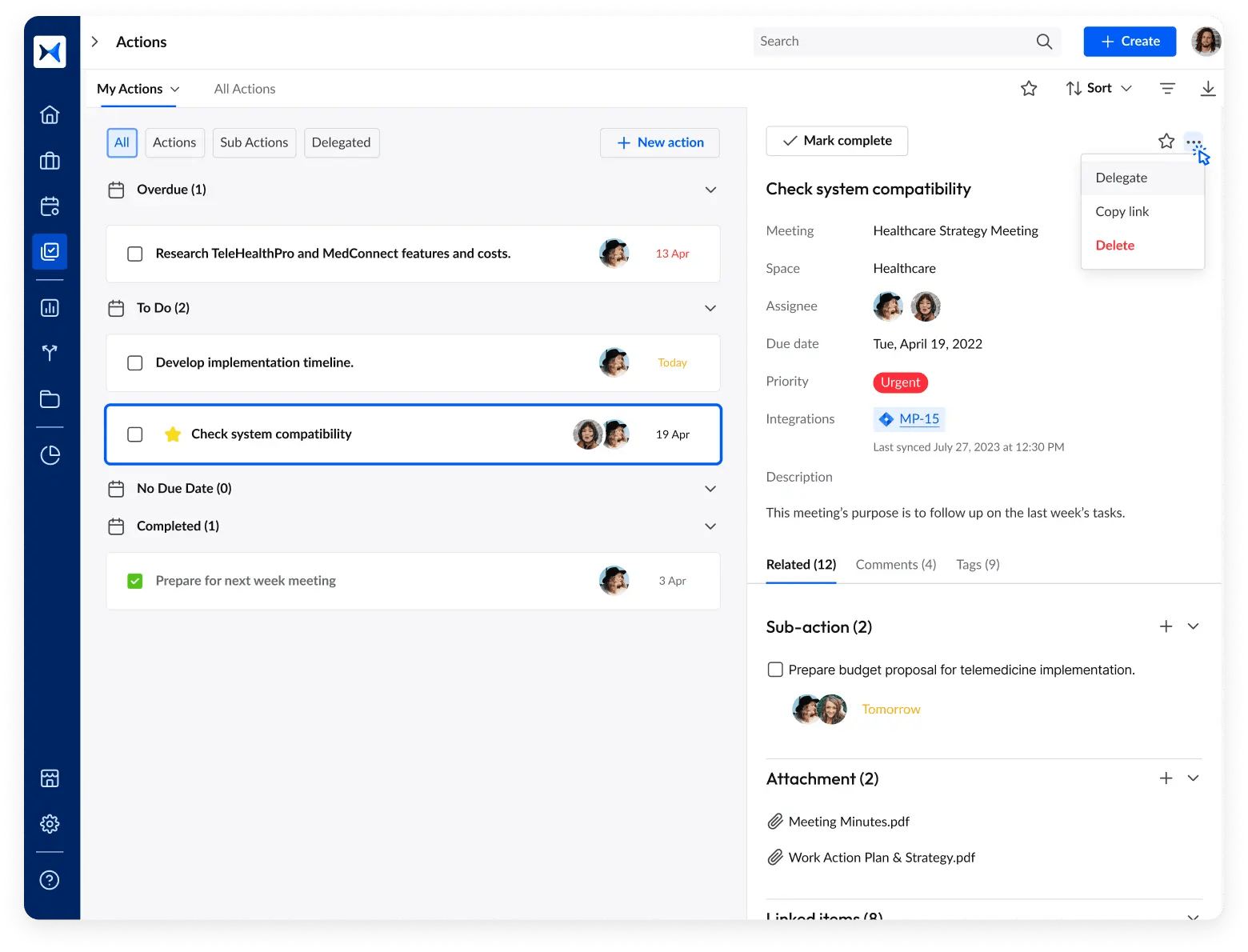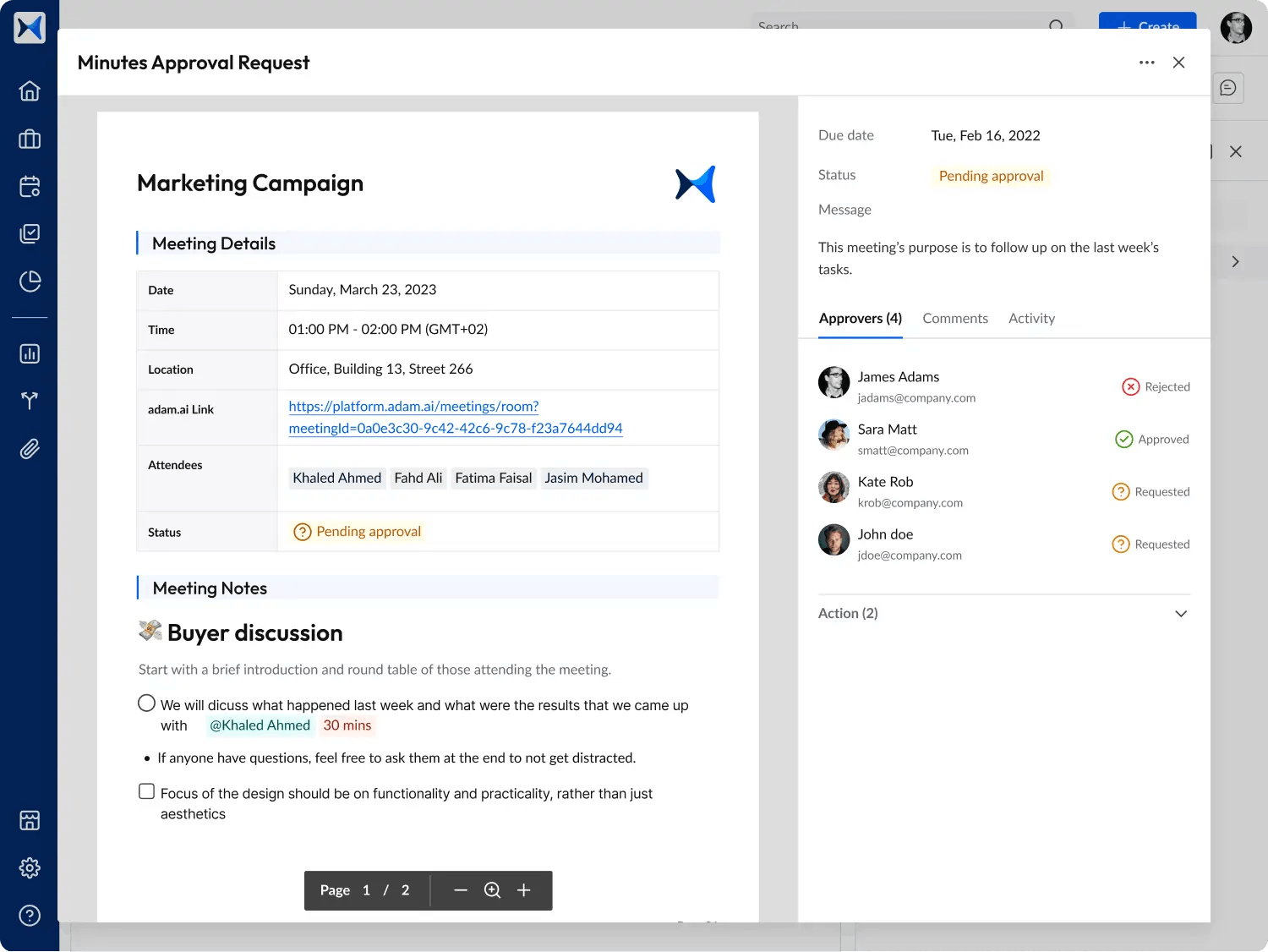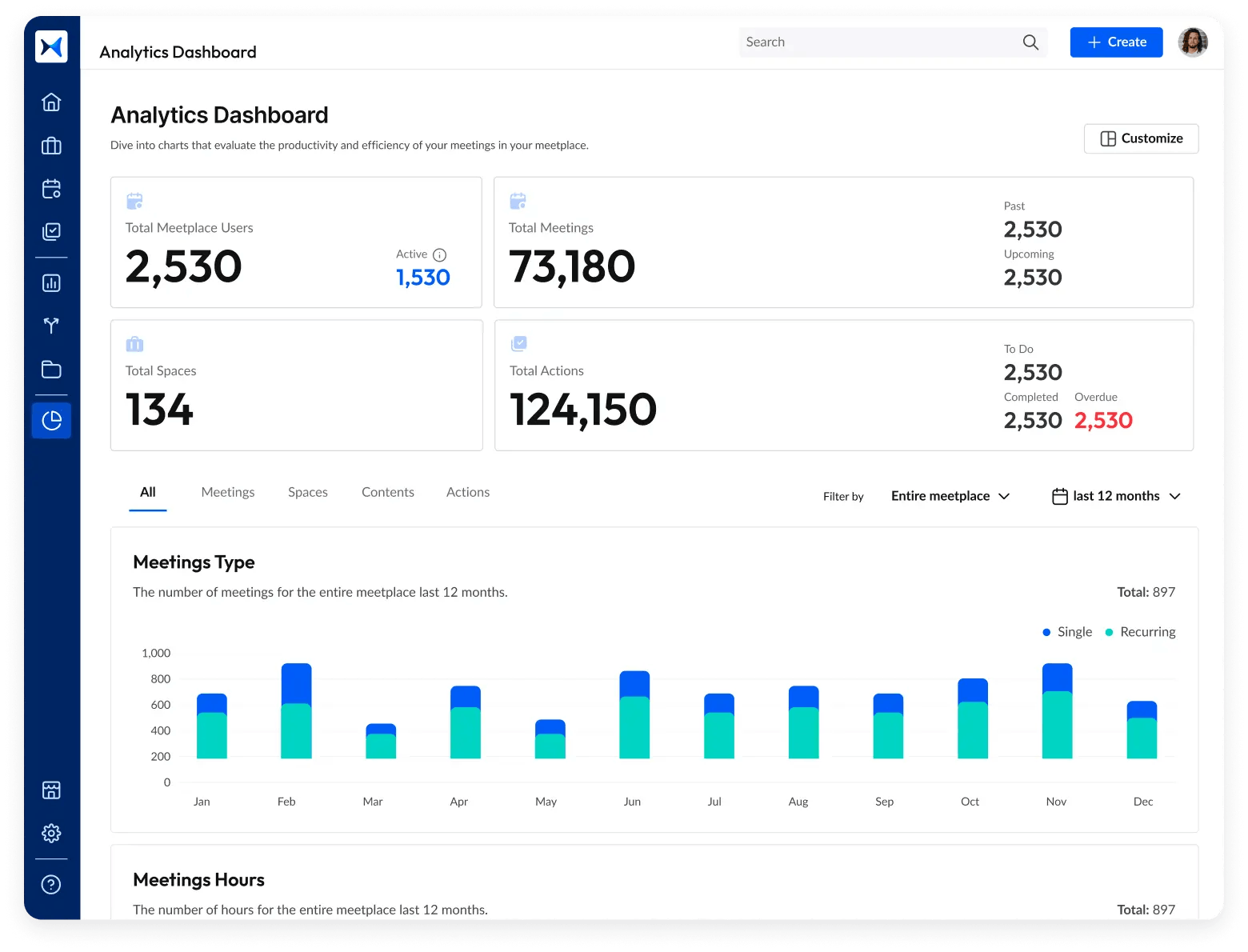September 3, 2024 · 10 min read
Strategic Alignment: Ensuring Project Success at the Executive Level

Shaimaa Badawi

Strategic alignment is the key to ensuring that every project within an organization drives long-term success. For executives, it’s not just about setting goals; it’s about ensuring that every initiative, decision, and resource allocation works in harmony with the company’s overarching objectives. In this article, we’ll explore how strategic alignment plays a critical role in guiding project outcomes, optimizing resources, and fostering collaboration across departments. Discover how aligning your projects with your business strategy can lead to greater efficiency, improved performance, and sustainable growth.
What is strategic alignment in project management?
Strategic alignment in project management refers to the process of ensuring that all projects within an organization are in harmony with its overarching business strategy and long-term goals. It involves aligning project goals, resources, and actions to directly support the organization's mission and vision, ensuring that every project contributes to achieving broader business objectives.
In practice, strategic alignment ensures that resources are allocated to projects that deliver the highest value, while unnecessary or misaligned projects are deprioritized. By keeping projects aligned with the company's strategic goals, organizations can enhance decision-making, improve efficiency, and maintain agility in a rapidly changing market.
This approach allows businesses to stay focused on initiatives that drive long-term success, rather than simply completing individual projects without considering their overall impact.
Why is strategic alignment important for business growth?
Strategic alignment is essential for business growth because it ensures that all departments, initiatives, and activities within an organization are working toward the same overarching objectives.
By aligning your business processes with the company's mission and vision, you can eliminate inefficiencies and ensure that resources are allocated to initiatives that directly support growth. When teams and leaders have a shared understanding of goals, it becomes easier to make decisions that drive scalability, improve market responsiveness, and enhance competitive advantage.
Aligned organizations can pivot more effectively when market conditions change, and they’re better positioned to seize opportunities or mitigate risks. By focusing on strategic alignment, businesses can streamline operations, reduce wasted effort, and create a culture where every action adds value to long-term growth. Ultimately, this alignment between business strategy and day-to-day operations builds a stronger foundation for sustained success.
What are the challenges of strategic alignment?
Strategic alignment can be difficult to maintain due to several challenges that organizations frequently face. Here are some of the most common challenges:
1. Unclear organizational goals
When a company’s overall direction, goals, and priorities aren't clearly defined or communicated, it leads to misunderstandings and inefficiencies. Without a clear understanding of the business’s vision, teams may struggle to align their efforts effectively.
2. Reluctance to embrace change
Resistance to change is common when individuals within the organization are hesitant to adapt to new strategies or processes. This can stem from comfort with the status quo or fear of the unknown, hindering the organization's ability to evolve and align with its strategic goals.
3. Lack of cross-department collaboration
When departments or teams operate in isolation, they often fail to share information and resources. This disconnect leads to inefficiencies and prevents the organization from working toward a unified goal. Fostering better collaboration is crucial for strategic alignment.
4. Weak leadership
If leaders within the organization lack the necessary skills or vision to guide strategic alignment, the process can quickly lose momentum. Strong leadership is essential to maintain focus and ensure that teams remain aligned with the organization’s long-term objectives.
5. External disruptions
Market changes, technological advancements, or new regulations can disrupt an organization's strategy. It’s essential for businesses to stay flexible and adapt to external factors, continuously aligning their strategy with the evolving business landscape.
What are the benefits of strategic alignment for projects?
Strategic alignment brings several benefits to projects by ensuring that every initiative is tied to the broader business goals of an organization. Here are the key benefits:
1. Optimized resource use
Strategic alignment allows decision-makers to make more informed choices about where to allocate resources. By focusing on projects that contribute directly to the company’s objectives, organizations can avoid overloading teams and ensure that every resource is used effectively. This streamlines project execution and improves overall efficiency.
2. Increased focus on business priorities
When all projects are aligned with the company’s goals, teams can concentrate their efforts on what truly matters. This alignment reduces distractions from low-priority or irrelevant projects, helping the organization maintain a sharp focus on delivering business value.
3. Enhanced executive support
Projects that are in sync with the organization’s strategic goals tend to attract greater involvement from top executives. When leadership sees that a project is critical to achieving business success, they are more likely to provide guidance and resources, ensuring the project moves forward with the necessary support.
4. Reduction of low-value projects
Aligning projects with strategy helps eliminate initiatives that no longer serve a purpose or fail to deliver significant value. This strategic focus allows organizations to clear out "pet projects" that consume resources but offer little return, improving overall productivity.
5. Stronger organizational performance
When projects are aligned with strategic objectives, the entire organization works more cohesively. This unified approach enhances collaboration across departments, improves communication, and fosters a culture of teamwork, all of which contribute to achieving better business outcomes.
6. Clearer decision-making processes
With a clearer understanding of which projects provide the most strategic value, teams can prioritize tasks and make decisions faster. This eliminates confusion and helps avoid the “loudest voice” problem, where decisions are influenced by who shouts the loudest rather than by strategic importance.
7. Improved project success and efficiency
Projects that are aligned with company strategy are more likely to meet their deadlines and stay within budget. This focus on alignment ensures that teams are working on the right projects, using resources wisely, and delivering results that drive business success.
8. Higher employee engagement and satisfaction
When employees understand how their work directly contributes to the company’s strategic goals, they are more engaged and motivated. This sense of purpose helps foster a positive work environment, improving job satisfaction and overall productivity.
9. Better adaptability to change
Strategic alignment ensures that teams are flexible and ready to adapt to changes in the business landscape. By keeping projects aligned with broader objectives, organizations can quickly pivot when needed without losing sight of their long-term goals, making them more resilient in the face of unexpected shifts.
10. Increased value realization
With clear strategic alignment, teams know exactly what value their projects are expected to deliver. This focus on outcomes rather than outputs ensures that all efforts contribute to the company’s success, resulting in stronger value realization and more measurable benefits.
How can C-level executives ensure project success through strategic oversight?
To ensure project success through strategic oversight, C-level executives need to take a proactive and holistic approach to managing projects across the organization. Here’s how they can achieve this:
1. Understand the company’s strategic goals
Executives must have a clear understanding of the organization’s long-term vision and objectives. By aligning projects with these goals, they can ensure that each initiative contributes to the overall mission. Engaging with other top-level leaders to discuss strategy helps set the foundation for aligning projects with business priorities.
2. Develop a strategic framework
Executives should create a roadmap or strategic playbook that outlines the key objectives, priorities, and measures of success for the organization. This framework serves as a guide for teams to follow, helping them prioritize projects and make decisions based on strategic value. Regular reviews of this plan will keep the company’s direction flexible and adaptive to change.
3. Foster cross-department collaboration
Successful strategic oversight involves breaking down silos and encouraging teams across different departments to work together. C-level executives should foster a collaborative environment where cross-functional teams align their efforts with the organization’s common goals. This collaboration improves transparency and ensures that everyone remains focused on the strategic objectives.
4. Secure senior leadership sponsorship
Getting buy-in from senior leaders is crucial for driving strategic alignment. C-level executives need to ensure that their leadership team is fully committed to aligning projects with the organization’s strategy. This involves regular communication with stakeholders to ensure their involvement in prioritizing and supporting key initiatives.
5. Track progress and measure success
To ensure project success, C-level leaders must continuously track and measure the alignment of projects with strategic goals. Implementing tools like OKRs (objectives and key results) helps monitor progress and ensure that all efforts are driving value for the business. This data-driven approach allows executives to adjust priorities when needed and keep projects on course.
How does strategic alignment integrate into the project planning process?
Strategic alignment is not a standalone task but a critical part of the entire planning and execution process within an organization. To ensure projects are aligned with long-term goals and objectives, here’s how strategic alignment integrates into each phase of the planning process:
1. Defining vision and mission
Alignment begins by clearly defining the organization's mission and vision. Leaders need to ensure that the overall purpose and direction of the company are shared and understood across the organization. This step ensures everyone is working toward the same long-term objectives, laying the foundation for future alignment.
2. Data-driven strategic analysis
During the analysis phase, gathering comprehensive data is crucial. Strategic alignment at this stage ensures that decisions are made based on a clear understanding of market conditions, customer needs, and internal capabilities. Any gaps between the organization’s current state and its goals are identified, allowing for realistic and relevant strategy formulation.
3. Goal setting and prioritization
Projects must be structured around measurable, actionable goals. Strategic alignment ensures that goals across all departments and teams cascade from the broader objectives of the company. This approach avoids misaligned initiatives and helps prioritize resources toward the most critical goals.
4. Formulating the strategy
At this stage, alignment means ensuring that the strategy connects high-level business objectives with real, actionable projects. Whether it’s ongoing operational improvements or transformative projects, alignment ensures that these efforts are tied to the company’s strategic goals and vision. Involving mid-level management can enhance alignment, as these teams are closer to the execution level and more in tune with operational realities.
5. Creating an action plan
Strategic alignment is key when making decisions about where to invest, which projects to pursue, and which initiatives to deprioritize or halt. It helps organizations focus on the opportunities that will provide the greatest long-term value, rather than spreading resources too thinly across many areas.
6. Executing the strategy
For execution, alignment ensures that teams are motivated and understand their role in achieving the organization’s strategic goals. It's important that decisions made during execution are tied back to the company’s broader strategy, ensuring that even tactical decisions align with long-term objectives.
7. Ongoing evaluation and adjustment
Finally, alignment continues into the evaluation phase, where it’s essential to track the success of projects based on strategic value, not just on time and budget metrics. This ongoing process ensures that as market conditions or business needs evolve, the organization's strategy can adapt accordingly while remaining aligned with core objectives.
Optimize strategic project alignment with adam.ai
For executives looking to ensure strategic alignment across their project portfolios, adam.ai offers a suite of powerful tools designed to keep your teams and objectives on track. As a meeting management platform built for project success, it provides a centralized solution to streamline communication, collaboration, and oversight across departments, ensuring every project aligns with your organization’s long-term goals:
- Seamless collaboration for strategic decision-making
Effective project alignment requires clear communication. adam.ai enables executives and teams to collaborate on project updates and decisions, ensuring all stakeholders are aligned and working toward common strategic priorities.

- Action and decision tracking for accountability
Keep your strategic initiatives on track by using adam.ai’s action tracking tools. Assign tasks, monitor progress, and hold teams accountable for delivering outcomes that align with your organization’s strategy.

- Multi-space management for streamlined oversight
Manage multiple projects, departments, and teams with adam.ai’s multi-space functionality. This feature allows you to oversee various workstreams simultaneously while ensuring that every project is aligned with broader business objectives, enabling seamless organization across departments.

- Automated meeting documentation and reporting
Automate the creation of meeting minutes and reports with adam.ai, capturing every discussion, decision, and follow-up. This ensures key insights are documented and available for ongoing project alignment.

- Analytics dashboard for strategic insights
Access real-time insights with adam.ai’s analytics dashboard, giving executives a clear view of meeting outcomes, project performance, and overall progress. These data-driven insights help drive smarter decision-making and ensure that projects remain aligned with strategic objectives.

Transform how you conduct critical meetings—From meticulous preparation to effective execution and insightful follow-up, adam.ai integrates comprehensive analytics, full customization, and intuitive interfaces with powerful meeting management tools.
Easy onboarding. Enterprise-grade security. 24/7 dedicated support.
The bottom line
Strategic alignment is essential for any organization that seeks to ensure project success and achieve sustainable growth. Modern tools play a crucial role in maintaining this alignment, providing real-time insights and seamless collaboration to keep projects on track and aligned with executive vision.
And while there may be multiple solutions available, here is why adam.ai is the meeting management software platform you can trust:
- adam.ai is one of Atlassian Ventures' portfolio companies.
- In the meeting management software category on G2, adam.ai has been ranked a leader and a high performer for successive quarters in the past years.
- adam.ai has been included in the Forrester Report in the AI-enabled meeting technology landscape.
- adam.ai is trusted and used by powerful teams and organizations worldwide for all types of critical meetings, like board, committee, project management, and business development meetings.
- And most importantly, adam.ai integrates with your existing workflow, is SOC2 compliant, provides dedicated support and success, and has a free trial option.
Subscribe to adam.ai blog
Stay ahead with the latest insights—get our newest blog posts, tips, and updates sent straight to your inbox.